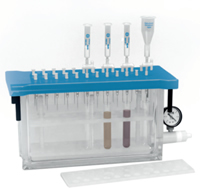SPE Guide

Sample Preparation
For as long as scientists have been analyzing compounds, there has been a need for sample preparation to extract and purify sample components.
Today’s technology for sample preparation, Solid Phase Extraction (SPE), is grounded in the principles of chromatography and offers increased speed, reduced hazardous solvent use and exposure, and improved reproducibility of the separation when compared to other wet chemistry methods, such as liquid/liquid extraction.
The Purpose of Sample Preparation
Sample clean up - necessary to eliminate impurities and/or isolate the component of interest from the matrix. This helps to increase lifetime of the analytical column, prevents contamination of equipment, thereby protecting expensive instrumentation.
Sample concentration - iIn order to reach the detection limits of the analytical equipment. Sample preparation selectively concentrates the components of interest prior to analysis.
Polymer-based Columns
These resin particles have a large surface area and are highly rigid and stable over pH range 1–14, in addition to being water-wettable and not impacted by sorbent drying. Columns are available in hydrophobic, hydrophilic, and ion exchange forms, suitable when advanced detection methods will be used.
Silica-based Columns
SPE silica-based sorbents provide predictable and consistent extractions for discrete subsets of a broad range of sample types. Mixed-mode sorbents can be used for the extraction of compounds from more complex matrixes.
To carry out solid phase extraction, a manifold such as this is required. It includes: 1 glass vacuum chamber, 1 nylon cover with luer fitting connectors and 1 polyethylene gasket, 24 individual flow control polypropylene stopcocks, 24 stainless steel needles, 1 sample collection rack with 3 support posts, 3 height adjustable shelves, 9 shelf support clips, 1 vacuum gauge/polypropylene controller assembly, 1 instruction sheet.